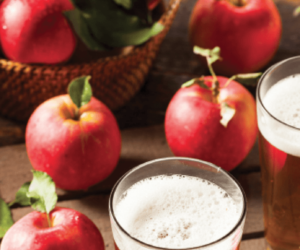Dry-Hopped Hard Cider Recipe
by Bryan Holmes • Citizen Cider, Essex, Vermont
(5 gallons/19 L)
OG = 1.060 FG = 0.998 ABV = ~8%
Ingredients
5.5 gallons (21 L) sweet apple cider
1.5–2 lbs. (0.7–0.9 kg) sugar
1 package dry Champagne yeast
Fermentation nutrients (e.g. Fermaid K, DAP)
Yeast rehydration nutrient (e.g. Fermaid Protect)
Potassium metabisulfate (KMS) or Campden tablets
Pectinase
Cascade Hops (whole or pellets)
Potassium sorbate (optional)
Step by Step
Sanitize your equipment using a product such as Star San. Do not use halogen-based sanitizers such as Iodophor. As soon as the cider is pressed and in the sanitized carboy, stir in 0.6 grams (0.12 grams per gallon) of potassium metabisulfite (KMS) for a target of 30 ppm free sulfites. Alternatively, you can use crushed Campden tablets to achieve 30 ppm free sulfites in 5 gallons (19 L).
To remove pectin and clarify the juice, add pectinase enzyme. Leave overnight and rack the juice into a sanitized carboy, leaving the sediment at the bottom of the first carboy.
Using your thermometer, rehydrate the dry yeast in 104 °F (40 °C) water with the yeast rehydration nutrient, following your yeast rehydration nutrient manufacturer’s instructions. You do not want to add the yeast to your cool cider if the difference in temperatures of the yeast and the cider exceed 15 °F (8 °C). To avoid temperature shock, you should acclimate your yeast by taking about 10 mL of the cider and adding it to the yeast suspension. Wait 15 minutes and measure the temperature again. Do this until you are within the specified temperature range. Do not let the yeast sit in the original water suspension for longer than 20 minutes. Now pitch the yeast/nutrient/cider combination into the main volume of cider.
At the beginning of the fermentation, add a nitrogen source, such as Diammonium Phosphate (DAP) or Fermaid K. Follow the directions on the package. Often cidermakers will add half of the total needed nitrogen at the beginning of the fermentation and the second half after 1⁄3 of the sugars have been depleted. Use your hydrometer before the yeast is added to determine the initial sugar concentration and make measurements daily to know when to make the second nitrogen addition. A 10% sugar. Give the carboy a stir daily to rouse the sediment off of the bottom. Once the airlock has stopped bubbling and your hydrometer readings have stabilized just below 0.000 units, the fermentation has finished. Using a siphon, rack the dry cider into a clean, sanitized carboy. Add KMS or Campden tablets to bring the free sulfites up to 0.5–0.8 ppm molecular SO2. 0.8 ppm will give you about 99% protection against spoilage where 0.5 ppm is the minimum for protection. The trade off is that sulfur aromas (matchstick) may be detectable at the higher molecular SO2 levels. The amount of KMS or Campden tablets you need to add is based on the pH of the dry cider, so you have to measure the pH using a pH meter or with test strips. Alternatively, you could ask a local cidermaker, winemaker or brewer to make the measurement for you. Use an online sulfite calculator to calculate how many grams of KMS or Campden tablets you will need to reach your target SO2 level (http://www.winemakermag.com/guide/sulfite). Initially, multiple additions may need to be made to get the target level. Do not make more than one KMS or Campden addition per day.
Allow the cider to age, settle and clarify. After it clarifies, rack the dry cider into a clean, sanitized carboy. Aging time can be two or more months. Maintain free/molecular SO2 levels by using SO2 test kits (e.g. Accuvin) every few weeks and adding KMS or Campden tablets as necessary.
Dry Hopping
After the cider has sufficiently aged, add around 1.4 oz. (40 grams) of Cascade hop cones or pellets to the carboy. Sparge the carboy with an inert gas to displace the oxygen in the fermenter. Carbon dioxide is a good choice if you already have it in your homebrewery for kegging.
After four to seven days, rack the cider off of the settled hops and bottle or keg. Continually taste the cider until you’ve reached the desired aroma/flavors/ Since hop compounds are especially sensitive to oxidation, keeping oxygen at a minimum by sparging for a few minutes with CO2 will increase the shelf life and preserve aroma. To carbonate, shake the keg under about 30–40 PSI of head pressure for about 5 to 10 minutes while the keg is at refrigerator temperature.
For an off-dry or sweet cider, add about 50 to 400 grams (1.5 to 14 oz.) of sugar to the cider in a Corny keg. This should be done to taste. For off-dry, it is recommended here to start around 15 grams (~5 oz.) To prevent refermentation, add 3.5 grams (0.05 oz.) of potassium sorbate to the cider and refrigerate it at around 35 °F (2 °C) or below overnight. This cooling step must be done since the yeast must be dormant to prevent refermentation. To carbonate, shake the keg under about 30–40 PSI of head pressure for about five to ten minutes while the keg is at refrigerator temperature (between 35–38 °F/1.7–3.3 °C).
Written by Bryan Holmes




